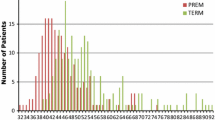Abstract.
In a retrospective study, we examined 23 pre-term infants (18 boys, 5 girls) with a median weight of 1540 g (range 720–2770 g) and a median age of 32 weeks (range 25–36 weeks) gestation, who were subsequently operated on after a median of 65 days (range 20–121 days) for 33 inguinal hernias. The infants were evaluated with respect to concomitant diseases as well as peri- and postoperative complications. The following surgical procedure was used in all patients: a high suture ligation after excision of the hernia sac, followed by closure of the groin according to Grob in boys, and according to Bassini in girls. Co-morbidity was high in the pre-term infants, both pre- and perinatally. Despite this high co-morbidity and a high rate of emergency operations due to incarcerations, the postoperative complication rate was very low. However, the rate of testicular atrophy (10%) and recurrent inguinal hernia (9%) registered by us in the median follow-up of 575 days (range 105–1118 days) was much higher than that seen in older infants. Nevertheless, based on the low perioperative complication rate registered in the present study, we postulate that early surgery is tenable in pre-term infants despite the high co-morbidity and is even meaningful for the purpose of reducing the high rate of incarceration and testicular atrophy. The high recurrence rate in pre-term infants appears to be related to the numerous concomitant diseases in these patients, the resultant increase in intra-abdominal pressure and the small size of anatomical structures.
Similar content being viewed by others
Author information
Authors and Affiliations
Additional information
Electronic Publication
Rights and permissions
About this article
Cite this article
Fette, .A., Höllwarth, .M. Special aspects of neonatal inguinal hernia and herniotomy. 5, 92–96 (2001). https://doi.org/10.1007/s100290100011
Received:
Accepted:
Issue Date:
DOI: https://doi.org/10.1007/s100290100011




